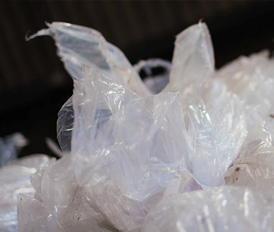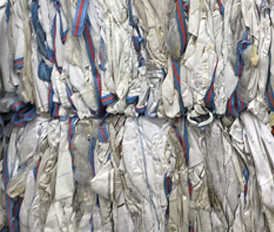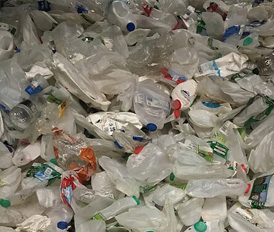HDPE Recycling
Polyethylene (PE) is a thermoplastic; due to its lightweight, durable, chemical resistant structure it is one of the most popular choices used of plastic in manufacturing. PE is highly versatile due to the variety of densities that it is available in, giving the material a wide spectrum of different functionalities.
Home - HDPE

HDPE Recycling
High-density polyethylene (HDPE) is the form of polyethylene in which the molecular structure is of increased density. The high tensile strength and resistance to low temperatures, among other properties, mean this polymer has a great number of different applications. This material can enter the waste stream as milk bottles, shopping bags, cereal box liners, toys, chemical containers, and piping, among many other possible product options. Once these goods have been disposed of, they will be gathered and prepared for recycling by a waste management company. From here the scrap material will be sent to a company such as Pakire Polymers that specialises in recycling and repurposing plastic waste. The recycler will segregate, clean, shred and then melt the plastic for it to form new plastic pellets fit for manufacturing. Pakire Polymers uses EREMA pellet technology, which is unparalleled in the industry, to produce the highest quality of recycled plastic pellet available. These pellets are then ready to be sold to manufacturers so they can be made into new products and given a new lease on life.
 HDPE Recycling
HDPE Recycling
A triangle with the number 2 will often appear on products that have been manufactured using high-density polyethylene. This is the American Society for Testing and Materials’ (ASTM) Resin Identification Code (RIC) number that is given to HDPE. It is important to ensure that plastics are separated out into their individual groups as much as possible when recycling, as a mixing of polymers can risk the recyclability of the material. The RIC gives a different number to different polymers to make it easier to identify the specific type of plastic being handled and increase the efficiency, as well as maximising the output, of the plastic recycling process.
Contact Us
Enquire about buying or selling plastic scrap
Other Materials We Recycle
Low-Density Polyethylene (LDPE)

As the name suggests, low-density polyethylene (LDPE) has a lower molecular density than other types of polyethylene.
PP Recycling & Recycle 5 PP

Due to the diverse range of functions polypropylene (PP) can perform, it enters the waste streams from a number of different sources.
We Also Accept These Materials
PET Plastic Materials - Polyethylene Terephthalate (PET) is a thermoplastic formed by the combination of ethylene glycol and terephthalic acid. It is a popular choice in food and beverage packaging as it is a clear, strong and lightweight plastic; nearly all single-use plastic drinks bottles are made from this particular polymer. The uses of PET are not limited to drinks bottles; it is also frequently used in carpets, sleeping bags, automotive parts and many other products.

PVC Plastic Materials - Polyvinyl Chloride (PVC) is a thermoplastic synthesised by combining ethylene and chlorine. PVC is a highly versatile material and can be made into an array of products; it can be easily shaped and sets very hard, making it the perfect material for automotive parts or construction materials. With the use of additives, PVC can also be made very soft and flexible, making it ideal for products such as polyvinyl flooring or upholstery.

PS Plastic Materials - Polystyrene (PS) is a thermoplastic; it is a hydrocarbon polymer sequenced from the monomer styrene. PS is highly adaptable as it can come in the form of a solid plastic or a rigid foam. When solid, PS is a popular choice for items such as food and beverage packaging and laboratory ware. When mixed with colorants or additives it can also be used in parts for electrical appliances, gardening equipment and many other products. Foam PS will often be over 95% air and makes for an excellent insulant; therefore, it is a popular choice for insulating homes and appliances, as well as for products such as food packaging and even surfboards.

PC Plastic Materials - Polycarbonate (PC) refers to a group of thermoplastics that contain carbonate groups within their chemical composition. PC polymers are very strong, lightweight and are resistant to impact, heat and chemicals. The properties of PC make it suitable for a variety of products such as medical equipment, automotive parts, construction materials, food packaging and many others.

ABS Plastic Materials - Acrylonitrile Butadiene Styrene (ABS) is a thermoplastic synthesised from the combination of three monomers: Acrylonitrile, butadiene and styrene. ABS is a very strong and stiff material with high levels of impact and corrosion resistance; it is regarded as being a particularly useful polymer in engineering. The properties of ABS make it an ideal choice for use in manufacturing products such as tools, plug sockets, electronics components and a variety of others.

EPS Plastic Materials - Expanded Polystyrene (EPS) is a thermoplastic sequenced from the monomer styrene. EPS is made by using steam to heat polystyrene (PS) beads, decreasing their density and allowing them to hold air in their interior. In order to prevent creating a vacuum when cooling the newly expanded beads, the rate at which the air is allowed to leave will be slowed using a process called air diffusion. The stabilised beads will then be placed into a mould and exposed to steam once again causing them to bind together and form the finished product. EPS is a very lightweight material and can be made very tough relative to its low density. This material is frequently used to store and transport fresh foodstuffs, as protective packaging materials for electronic items, in sports equipment and in furniture items.

Work with Us
If you have a passion for recycling and for achieving a sustainable future, then we want to hear from you.











